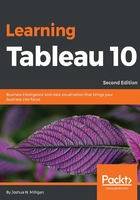
What this book covers
Chapter 1, Creating Your First Visualizations and Dashboard, introduces the basic concepts of data visualization and shows multiple examples of individual visualizations that are ultimately put together in an interactive dashboard.
Chapter 2, Working with Data in Tableau, explains that Tableau has a very distinctive paradigm for working with data. This chapter explores that paradigm and gives examples of connecting to and working with various data sources.
Chapter 3, Moving from Foundational to More Advanced Visualizations, expands upon the basic concepts of data visualization to show how to extend standard visualization types.
Chapter 4, Using Row-Level, Aggregate, and Level of Detail Calculations, introduces the concepts of calculated fields and the practical use of calculations. The chapter walks through the foundational concepts for creating Row Level, Aggregate, and Level of Detail calculations.
Chapter 5, Table Calculations, is about table calculations, one of the most complex and most powerful features of Tableau. This chapter breaks down the basics of scope, direction, partitioning, and addressing to help you understand and use them to solve practical problems.
Chapter 6, Formatting a Visualization to Look Great and Work Well, is about formatting, which can make a standard visualization look great, have appeal, and communicate well. This chapter introduces and explains the concepts around formatting in Tableau.
Chapter 7, Telling a Data Story with Dashboards, dives into the details of building dashboards and telling stories with data. It covers the types of dashboards, objectives of dashboards, and concepts such as actions and filters. All of this is done in the context of practical examples.
Chapter 8, Deeper Analysis – Trends, Clustering, Distributions and Forecasting, explores the analytical capabilities of Tableau and demonstrates how to use trend lines, clustering, distributions, and forecasting to dive deeper into the analysis of your data.
Chapter 9, Making Data Work for You, shows that data in the real world isn’t always structured well. This chapter examines the structures that work best and the techniques that can be used to address data that can’t be fixed.
Chapter 10, Advanced Visualizations, Techniques, Tips, and Tricks, builds upon the concepts in previous chapters and expands your horizons by introducing non-standard visualization types along with numerous advanced techniques, while giving practical advice and tips.
Chapter 11, Sharing Your Data Story, once you’ve built your visualizations and dashboards, you’ll want to share them. This chapter explores numerous ways of sharing your stories with others.